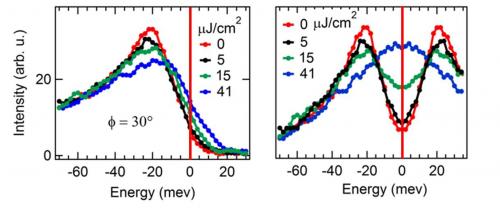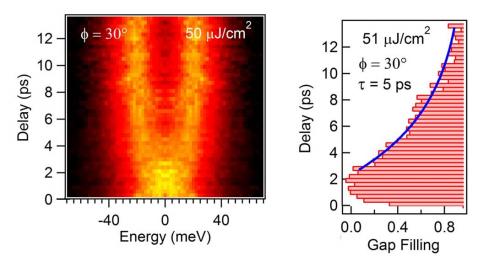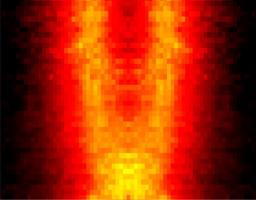

|
The discovery of superconductivity is more than 100 years old, and the BCS theory, describing the phenomenon in its conventional version, is now 60. Today, the mechanism at the heart of the "high temperature" superconductivity (non BCS), discovered 30 years ago, remains to be identified. In all cases, the superconducting phase is characterized by the opening of a gap between the occupied and unoccupied electronic states, which closes above the critical temperature, in the normal phase. In a joint project between the LSI, LPS and UPMC, it is observed by time-resolved angular resolved photoemission spectroscopy (TR-ARPES) that upon an ultra-short pulsed laser excitation of the electrons, the superconductor gap can be transiently closed in specific crystallographic directions, during a time in the femtoseconde range. This observation illustrates the potentialities of the method that provides a new way of exploring the mysteries of high temperature superconductivity. The method seems similarly promising in the investigation of the physics of fast electron dynamics of other strongly driven systems, like polaritons and ultracold atoms. |
When a material enters its superconducting phase, the electron spectrum presents an energetic gap at the Fermi level. This direct signature of the formation of electronic Cooper pairs can be observed by different methods. Among these, ARPES (Angle Resolved Photoelectron Spectroscopy) is one of the most direct and powerful: this technique allows mapping the Fermi surface and brought the conclusive proof that copper oxide superconductors exhibit an unconventional electron coupling. In particular, ARPES experiments show that the electron gap is strongly anisotropic: maximum along the direction of the copper-oxygen (antinodal direction) and minimal at 45 ° (nodal direction) [1]. Recently, time-resolved ARPES (TR-ARPES) has been developed to explore the electron dynamics [2]. A team of researchers from LSI, LPS and UPMC used this method to map the excitation and relaxation of the superconducting condensate at the picosecond scale.
The dynamics of the superconducting gap of a cuprate (Bi2Sr2CaCu2O8+δ) in its superconducting state (T


Left: Photoemisssion intensity versus initial electron energy after excitation by laser pulses of increasing intensity for (Bi2Sr2CaCu2O8+δ) in the superconductor state.
Right: the evolution of the electronic spectrum is better visualized by symmetrizing the photoelectron intensity maps with respect to the Fermi level that is accurately defined. A 10 meV supraconductor gap is clearly shown that closes upon laser excitation.

Map of the evolution of the density of states during the electronic relaxation. Left: symmetrized density of states around the Fermi level. Right: evolution as a function of time of the gap filling after the initial electronic excitation by the femtosecond laser pulse.
Due to the instantaneous electron pairs breaking, the closing of the gap takes place within the duration of the pump laser pulse. Conversely, the reopening of the gap requires that the excited electrons dissipate their excess energy into the crystal lattice by the excitations of phonons. After a few picoseconds, the "hot" electrons have cooled down below the condensation temperature, the Cooper pairs become stable again and the gap is restored. However, this process does not occur equally in all crystallographic directions, as shown by the mappings of the reciprocal space allowed by the TR-ARPES technique. It is observed that the energy density threshold for a complete gap closure is function of the direction of observation of the electrons: it is in the direction of the copper-oxygen bonds that the gap is more robust and shows a higher perturbation upon the laser excitation. This marked anisotropy is important information about the unconventional pairing mechanism in copper oxide superconductors.
Interestingly, an additional measure of the low-frequency electrodynamics shows that Cooper pairs, with angular momentum oriented in the directions of the Cu-O bonds, remain, but they are no longer able to be the carriers of a super-current [3]. The moderate photo-excitation of the laser pump pulse alters only the macroscopic phase coherence between the paired electrons. The condensation of the Cooper pairs, intrinsically linked to superconductivity, can thus be studied and manipulated by laser excitation. The technique of TR-Femto-ARPES thus appears as a powerful tool to decipher high temperature superconductivity.
This provides the right tool to search for experimental protocols improving the coherence of the condensed phase instead of reducing it. Recent experiments suggest that this may be possible if the system is photo-excited in resonance with lattice modes that oscillate perpendicularly to superconducting planes [4]. Understanding the physics of such an out-of-equilibrium condensate could even suggest leads to generate metastable phases able to carry supercurrents above the critical temperature!
The TR-Femto-ARPES technique thus appears as a powerful tool able to provide essential information on the mechanism of superconductivity at high temperature. The important point of the method is to allow exploring the out of equilibrium electronic structure that can thus be controlled. Beyond the superconductors, this type of study concerns other highly correlated electron systems, such as the study of polaritons or ultra-cold atoms.
References:
[1] Angle-resolved photoemission studies of the cuprate superconductors
A. Damascelli, Z. Hussain, Z.-X. Shen, Review of Modern Physics 75, 473 (2003).
[2] Quasiparticles dynamics in high-temperature superconductors far from equilibrium: an indication of pairing amplitude without phase coherence
C. Piovera, Z. Zhang, M. d'Astuto, A. Taleb-Ibrahimi, E. Papalazarou, M. Marsi, Z. Z. Li, H. Raffy, and L. Perfetti, Phys. Rev. B 86, 024413 (2012).
[3] Ultrafast dynamics of fluctuations in high-temperature superconductors far from equilibrium
L. Perfetti, B. Sciolla, G. Biroli, C. J. van der Beek, C. Piovera, M. Wolf, and T. Kampfrath, Phys. Rev. Lett. 114, 067003 (2015).
[4] Optically enhanced coherent transport in YBa2Cu3O6.5 by ultrafast redistribution of interlayer coupling
W. Hu, S. Kaiser, D. Nicoletti, C. R. Hunt, I. Gierz, M. C. Hoffmann, M. Le Tacon, T. Loew, B. Keimer and A. Cavalleri, Nature Materials 13, 705 (2014).
[5] Photoinduced filling of near nodal gap and dissipation of quasiparticles in Bi2Sr2CaCu2O8+d
Z. Zhang, C. Piovera, E. Papalazarou, M. Marsi, M. d'Astuto, C. J. van der Beek, A. Taleb-Ibrahimi, L. Perfetti, arXiv:1703.07860.
Contact CEA-IRAMIS : Luca Perfetti (IRAMIS/LSI)
Collaboration :
- C. Piovera, L. Perfetti : Laboratoire des Solides Irradiés, Ecole Polytechnique, CNRS, CEA, Université Paris-Saclay, 91128 Palaiseau cedex, France.
- Z. Zhang, M. d'Astuto : Institut de Minéralogie et de Physique des Milieux Condensés (IMPMC), UMR CNRS 7590, Université Pierre et Marie Curie - case 115, 4, place Jussieu, 75252 Paris cedex 05, France
- E. Papalazarou, M. Marsi : Laboratoire de Physique des Solides, CNRS, Université Paris-Saclay, Université Paris-Sud, 91405 Orsay, France.












